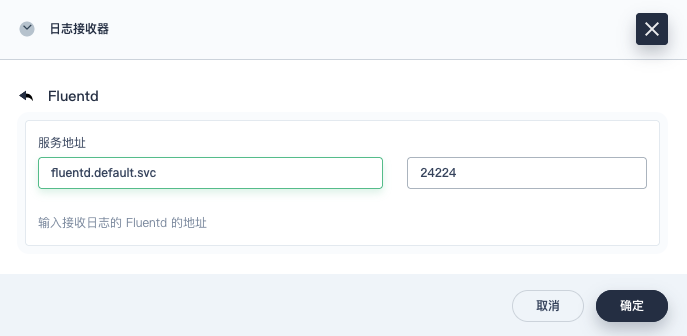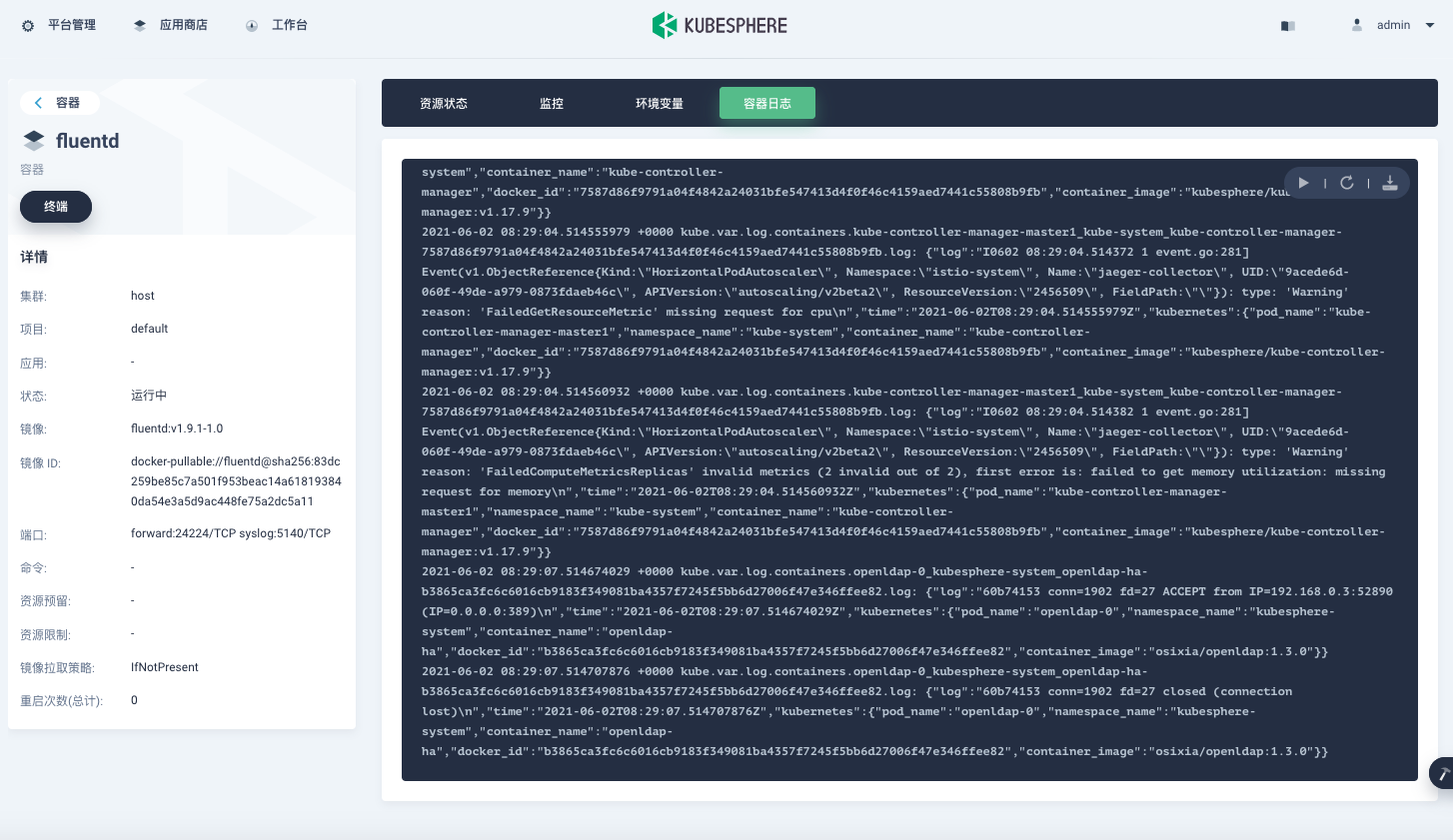
添加 Fluentd 作为接收器
您可以在 KubeSphere 中使用 Elasticsearch、Kafka 和 Fluentd 日志接收器。本教程演示:
- 创建 Fluentd 部署以及对应的服务和 ConfigMap。
- 添加 Fluentd 作为日志接收器以接收来自 Fluent Bit 的日志,并输出为 stdout(标准输出)。
- 验证 Fluentd 能否成功接收日志。
准备工作
-
您需要一个被授予集群管理权限的帐户。例如,您可以直接用
admin帐户登录控制台,或创建一个具有集群管理权限的角色然后将此角色授予一个帐户。 -
添加日志接收器前,您需要启用组件
logging、events或auditing。有关更多信息,请参见启用可插拔组件。本教程启用logging作为示例。
步骤 1:创建 Fluentd 部署
由于内存消耗低,KubeSphere 选择 Fluent Bit。Fluentd 一般在 Kubernetes 中以守护进程集的形式部署,在每个节点上收集容器日志。此外,Fluentd 支持多个插件。因此,Fluentd 会以部署的形式在 KubeSphere 中创建,将从 Fluent Bit 接收到的日志发送到多个目标,例如 S3、MongoDB、Cassandra、MySQL、syslog 和 Splunk 等。
执行以下命令:
备注
- 以下命令将在默认命名空间
default中创建 Fluentd 部署、服务和 ConfigMap,并为该 Fluentd ConfigMap 添加filter以排除default命名空间中的日志,避免 Fluent Bit 和 Fluentd 重复日志收集。 - 如果您想要将 Fluentd 部署至其他命名空间,请修改以下命令中的命名空间名称。
cat <<EOF | kubectl apply -f -
apiVersion: v1
kind: ConfigMap
metadata:
name: fluentd-config
namespace: default
data:
fluent.conf: |-
# Receive logs sent from Fluent Bit on port 24224
<source>
@type forward
port 24224
</source>
# Because this will send logs Fluentd received to stdout,
# to avoid Fluent Bit and Fluentd loop logs collection,
# add a filter here to avoid sending logs from the default namespace to stdout again
<filter **>
@type grep
<exclude>
key $.kubernetes.namespace_name
pattern /^default$/
</exclude>
</filter>
# Send received logs to stdout for demo/test purpose only
# Various output plugins are supported to output logs to S3, MongoDB, Cassandra, MySQL, syslog, Splunk, etc.
<match **>
@type stdout
</match>
---
apiVersion: apps/v1
kind: Deployment
metadata:
labels:
app: fluentd
name: fluentd
namespace: default
spec:
replicas: 1
selector:
matchLabels:
app: fluentd
template:
metadata:
labels:
app: fluentd
spec:
containers:
- image: fluentd:v1.9.1-1.0
imagePullPolicy: IfNotPresent
name: fluentd
ports:
- containerPort: 24224
name: forward
protocol: TCP
- containerPort: 5140
name: syslog
protocol: TCP
volumeMounts:
- mountPath: /fluentd/etc
name: config
readOnly: true
volumes:
- configMap:
defaultMode: 420
name: fluentd-config
name: config
---
apiVersion: v1
kind: Service
metadata:
labels:
app: fluentd
name: fluentd
namespace: default
spec:
ports:
- name: forward
port: 24224
protocol: TCP
targetPort: forward
selector:
app: fluentd
sessionAffinity: None
type: ClusterIP
EOF
步骤 2:添加 Fluentd 作为日志接收器
-
以
admin身份登录 KubeSphere 的 Web 控制台。点击左上角的平台管理,然后选择集群管理。备注
如果您启用了多集群功能,您可以选择一个集群。 -
在集群管理页面,选择集群设置下的日志收集。
-
点击添加日志接收器并选择 Fluentd。
-
输入 Fluentd 服务地址和端口信息,如下所示:

-
Fluentd 会显示在日志收集页面的接收器列表中,状态为收集中。
步骤 3:验证 Fluentd 能否从 Fluent Bit 接收日志
-
在集群管理页面点击应用负载。
-
点击工作负载,并从部署选项卡下的下拉菜单中选择
default项目。 -
点击 fluentd 项目并选择 fluentd-xxxxxxxxx-xxxxx Pod。
-
点击 fluentd 容器。
-
在 fluentd 容器页面,选择容器日志选项卡。
-
您可以看到日志持续滚动输出。

反馈
这篇文章对您有帮助吗?
感谢您的反馈。如果您有关于如何使用 KubeSphere 的具体问题,请在 Slack 上提问。如果您想报告问题或提出改进建议,请在 GitHub 存储库中打开问题。













 上一篇
上一篇
